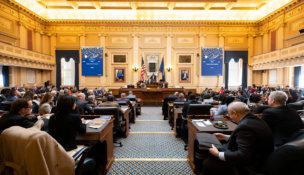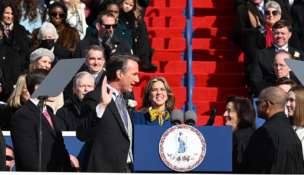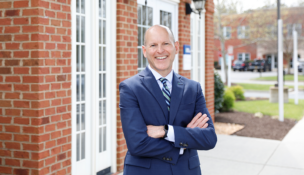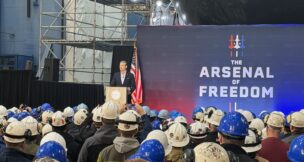Vibe check
Is a Great Resignation 2.0 ahead? Amid mixed signals, HR execs try to read the room
Beth JoJack //October 31, 2024//

Illustration by Miriam Foster

Illustration by Miriam Foster
Vibe check
Is a Great Resignation 2.0 ahead? Amid mixed signals, HR execs try to read the room
Beth JoJack //October 31, 2024//
No studies have found a higher prevalence of clairvoyance among labor market experts than in the average population.
Since they can’t see the future, these professionals sift through data and surveys to figure out what the coming months may hold. Some reading these tea leaves have predicted employers may soon be suffering through another wave of workers turning in their notices — the Great Resignation 2.0.
“People get very uneasy, and so they stay put. But the minute things shift, that’s when you start seeing people get really assertive, both in hiring and in their job search,” Shannon Gabriel, vice president of the leadership solutions practice at North Carolina-based TBM Consulting, told newsletter HR Brew in September.
The original Great Resignation — the term was coined by Anthony Klotz, a professor at University College London’s School of Management — was the mostly COVID-era period from March 2021 to June 2023 when a record number of workers quit their jobs. In 2022 alone, more than 50 million workers told their bosses “Adios!”
After the pandemic, experts have speculated, many workers were no longer willing to let their 9-to-5s take center stage. People started “recalibrating the way that they wanted to live their lives and how work was going to fit into it,” says Elizabeth Powell, an associate professor at the University of Virginia’s business and nursing schools.
While some industries shed jobs during the pandemic, others grew, creating opportunities for those looking for greener pastures.
“A lot of people were jumping ship to new companies because the pay was higher, because the benefits were better, because they could work remotely, all of these different things,” explains Sarah Wittman, assistant professor of management at George Mason University’s Costello College of Business.
Laura Bowser, managing director and human capital consulting practice leader at Fahrenheit Advisors, started working at the Richmond consulting firm in 2022, just in time to fully experience the O.G. Great Resignation. “It was wild,” she recalls. “People couldn’t keep any of their HR teams because HR folks were burning out left and right.”
That period was followed by the Big Stay, a phrase Nela Richardson, chief economist for New Jersey’s ADP Research, came up with to describe the slowdown in worker turnover immediately following the Great Resignation.
“The economy wasn’t doing as well, inflation was up,” explains Wittman. “And so, in times like that, especially with economic uncertainty, you know, mortgage rates being so high, you don’t just ditch out on a job. You tend to hunker down and stay.”
Which brings us back to the here and now, with labor experts murmuring about possible coming changes to the employment market.
Calling it quits
In August, the U.S. quits rate, the number of workers who voluntarily left their jobs during the entire month as a percent of employment, was 1.9%, the lowest rate since 2020. About 3.1 million Americans told employers to take this job and shove it in August, but that was 159,000 fewer resignations than in July.
Virginia’s quit rate for July, the latest available number as of press time, was 2.5%, higher than the 2.1% national rate that month. An estimated 105,000 workers exited jobs from Virginia employers that month, about 23,000 more than quit in June.
Neither the national nor the state quits rates make a convincing argument for a second Great Resignation on the horizon, according to John Provo, executive director of Virginia Tech’s Center for Economic & Community Engagement.
However, Provo points to the fifth annual PwC Global Workforce Hopes & Fears Survey. Released in June, it’s a vibe check of 56,000 workers polled across 50 countries and regions. Some 28% of respondents reported they would be “very or extremely likely” to switch employers over the next 12 months. During the Great Resignation in 2022, only 19% of workers surveyed gave a similar answer.
“What does it all mean?” Provo asks. “I don’t know that we know, but I definitely think it’s a thing to watch.”
In an August speech, Federal Reserve Chair Jerome Powell noted declining job vacancies and that hiring and quits rates have fallen below pre-pandemic levels seen in 2018 and 2019. “We do not seek or welcome further cooling in labor market conditions,” he said.
Prompted partially by a desire to stabilize a cooling job market, the Fed in September lowered interest rates by a half percentage point — marking its first cut since 2020.
Lowering borrowing costs could prompt companies to hire workers, experts say. The rate cut could also give employees confidence in the economy, which might provide them with a jolt of courage to seek out new jobs.
“[Consumer] prices are still going up, but not nearly by as much as before,” Wittman says. “Then we have the rate cut, and so people might have a little bit of hope on the horizon.”
Wait and see?
Employees who quit during the Great Resignation have been at their current jobs for about two years now, Wittman notes, and could be getting antsy. “That’s a long time here in the U.S.,” she says.
Restless though they may be, employees could be waiting, experts speculate, to see how November’s presidential election shakes out before launching a job search.
“You don’t know what’s going to happen there,” Wittman says, “or what sort of economic conditions will follow.”
Executives also seem to be following the Harris-Trump race closely.
A quarterly survey of chief financial officers by Duke University and the Federal Reserve Banks of Richmond and Atlanta, most recently released in September, found 30% of CFOs reporting that their companies are postponing, scaling down or canceling investment plans due to uncertainty around the election.
Another factor to consider: Some industries, like tech and legal, are undergoing a period of rightsizing after going on hiring sprees during and immediately after the pandemic.
“So, independent of who’s going to be occupying the White House, there are some market adjustments that will happen,” says Violet Ho, professor at the University of Richmond’s Robins School of Business.
Employers added 254,000 jobs in September, higher than the 140,000 jobs predicted by forecasters. That news comes on the heels of the unemployment rate dropping from 4.2% to 4.1% in September.
The higher-than-expected number of new jobs added, along with revised July and August numbers that showed the U.S. economy added 72,000 more jobs than previously reported, suggest “the labor market remains strong,” Provo argues.
And if the unemployment rate continues to decrease, Ho says, voluntary resignations could increase. “In part, this is because employees have more job opportunities to pursue and also may feel that they’ll have more negotiating power over employers,” she says.
Even so, economist Bob McNab, chair of Old Dominion University’s Department of Economics and director of the Dragas Center for Economic Analysis and Policy, remains skeptical that it will result in another Great Resignation.
“Even though we saw [September] job numbers … that were much stronger than expected, and even though job openings remain higher than pre-pandemic levels in Virginia and the United States,” McNab says, “workers are looking at the [overall] environment — inflation is decelerating, yes, but there’s an uncertain presidential election. There’s an uncertain global political environment. We just went through the uncertainty of a port strike. What do people do when they’re uncertain about the future? They’re less likely to quit their jobs.”
And businesses are taking much the same wait-and-see strategy. As an October Axios article noted, “Companies are hesitant to shrink or grow their payrolls for fear that they might be caught flatfooted if the economy revs up or unexpectedly slows down.”
Just as a combination of rare meteorological factors are required to create a perfect storm, a whole host of unusual variables would be needed to kick off a new wave of employees leaving their jobs.
After all, the Great Resignation was a reaction to the pandemic, which Ho calls a “huge environmental jolt.” And “in this case,” she says, “I’m not seeing any environmental jolt of that size. Even if there were to be some labor movements, I don’t think it will be as huge and as impactful.”
Ch-ch-changes
Another school of thought is that the Great Resignation wasn’t a one-off phenomenon, but the first glimpse of a workforce forever changed by the pandemic. “I’ve been thinking that it’s going to be more like just an ongoing recalibration that folks are going through with regard to how they want to spend their time — in their work, in their lives,” says U.Va.’s Elizabeth Powell.
It’s also possible that the workforce could be undergoing a generational evolution as boomers retire and Gen Z joins millennials and Gen Xers at the office.
With older generations, Wittman says, “there was much more anchoring within social structure. You had the pull of the family, you had the pull of community organizations, religious organizations. So many of these things for the normal American are just not there [now].”
A worker without additional anchor points, Wittman adds, will have a harder time accepting a difficult supervisor than the person who comes to work for a paycheck and finds greater fulfillment coaching Little League.
“When you have only the workplace that’s giving you fulfillment, or not, it’s more challenging, because then [work] absolutely needs to fit who you are in order for you to feel self-realized.”
Powell, who also directs U.Va.’s Compassionate Care Initiative, an effort that includes cultivating a resilient and caring health care workforce, shares the belief that younger workers might be willing to tolerate less at the office.
“So, boomers like myself might be motivated to work out of duty and a sense of obligation to the organization,” she says, while “younger workers now are looking for not only competitive pay, but also growth opportunities and meaning and purpose in their work.”
CEOs who dismiss Gen Z as being too demanding or delicate for work do so at their peril.
“You’re going to have to get over it,” Powell says, “or you’re not going to get anybody to work for you.”
Retention strategies
It’s cheaper to retain an employee than to hire a new one, Powell cautions.
Company leaders, she suggests, would be wise not to wait to take action until it’s too late. “Employers could make certain choices now that might maybe hedge against a Great Resignation,” she says.
To retain workers during the first Great Resignation, Bowser points out, employers increased pay and bonuses and, in general, worked harder at making employees happy. “What I’ve noticed is a lot of employers have kind of eased back into older habits,” she says. “I’m not seeing as many spot bonuses anymore. I’m not hearing of employers throwing money [at workers] as hard as they used to.”
But company leaders should invest in compensation so workers don’t put in two years and then jump to a competitor for a pay raise, Bowser says. She recommends that executives perform a compensation analysis every year to ensure wages are competitive. “Just pay and keep folks,” she says.
Over the past two years, The Branch Group, an employee-owned, heavy-highway construction and building contractor headquartered in Roanoke, has studied pay and benefits with an eye toward retention, says Tina Pfalzgraf, the company’s chief human resources officer. Branch added fertility insurance coverage for employees as well as a more generous leave policy, along with voluntary benefits like identity theft protection and pet insurance.
“We’ve been incrementally doing the things that we think matter most to our people so that they choose us as their employer of choice,” she says.

Natalie Sigmon, director of talent recruitment and retention for Roanoke’s Blue Eagle Credit Union and president of the Roanoke Valley Society for Human Resource Management, says that when she interviews prospective employees, she hears about how they’re looking for a role offering “growth and development.”
That doesn’t mean everyone wants to be the boss, though. “I’m definitely seeing that people don’t necessarily want that responsibility,” says Sigmon, who stresses the idea of a career lattice, instead of a ladder. With a lattice, employees can make lateral moves to other departments or even take a role with less responsibility if that’s a better fit for their lives.
Companies, Sigmon says, could consider developing a healthy budget to support training needs to allow for this kind of movement. “Certainly, people want to learn more,” she says.
Another simple way to boost employee retention is to make sure workers understand the value of their total compensation.
Branch does that by offering trainings on what it means to be part of an employee-owned company. Blue Eagle Credit Union hands out tip sheets illustrating how much the organization spends on benefits, trainings and additional programs.
“There’s the number that you think you see on your W2 or on your paycheck, but here’s what it really encompasses,” Sigmon explains.
As far as what not to do, U.Va.’s Powell warns against investing money and energy into trendy wellness programs. Those, she says, don’t do much to foster the kind of healthy work cultures that retain employees as the things that really matter.
“It’s not my access to going to yoga at lunchtime,” she says. “It’s, is there skilled communication? Is there true collaboration at work, or is there effective decision-making or is staffing adequate? Is there meaningful recognition? Are my leaders mindful and authentic people?”
















